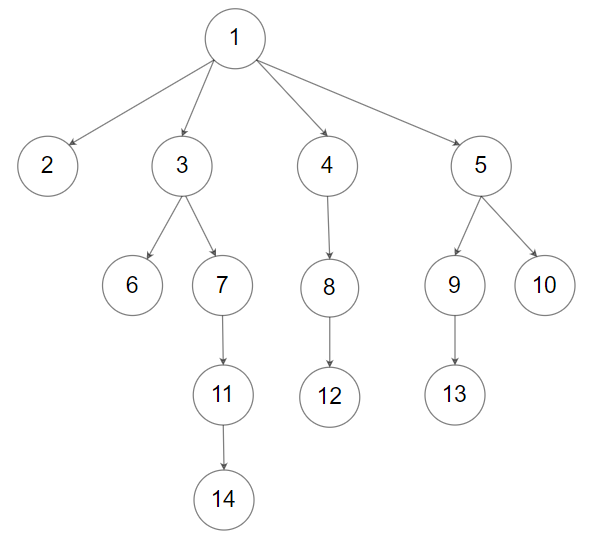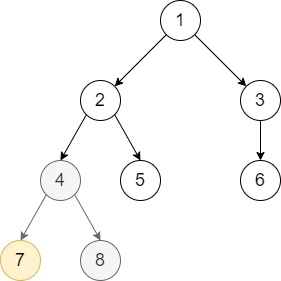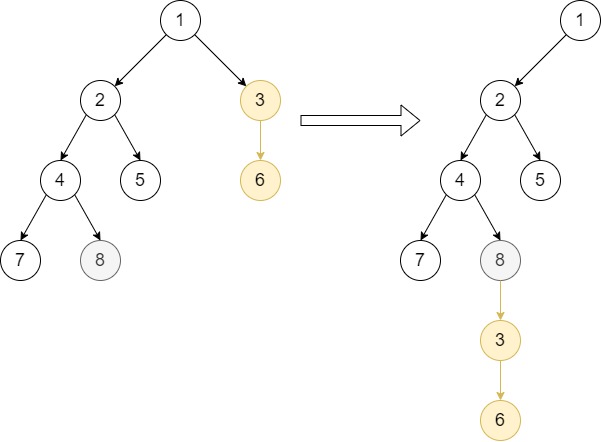Given the root of an N-ary tree of
unique values, and two nodes of the tree p and q.
You should move the subtree of the node p to become a
direct child of node q. If p is already a direct
child of q, don't change anything. Node p must
be the last child in the children list of node q.
Return the root of the tree after adjusting it.
There are 3 cases for nodes p and q:
- Node
qis in the sub-tree of nodep. - Node
pis in the sub-tree of nodeq. - Neither node
pis in the sub-tree of nodeqnor nodeqis in the sub-tree of nodep.
In cases 2 and 3, you just need to move p (with its
sub-tree) to be a child of q, but in case 1 the tree may be
disconnected, thus you need to reconnect the tree again. Please read the
examples carefully before solving this problem.
Nary-Tree input serialization is represented in their level order traversal, each group of children is separated by the null value (See examples).

For example, the above tree is serialized as [1,null,2,3,4,5,null,null,6,7,null,8,null,9,10,null,null,11,null,12,null,13,null,null,14].
Example 1:

Input: root = [1,null,2,3,null,4,5,null,6,null,7,8], p = 4, q = 1 Output: [1,null,2,3,4,null,5,null,6,null,7,8] Explanation: This example follows the second case as node p is in the sub-tree of node q. We move node p with its sub-tree to be a direct child of node q. Notice that node 4 is the last child of node 1.
Example 2:

Input: root = [1,null,2,3,null,4,5,null,6,null,7,8], p = 7, q = 4 Output: [1,null,2,3,null,4,5,null,6,null,7,8] Explanation: Node 7 is already a direct child of node 4. We don't change anything.
Example 3:

Input: root = [1,null,2,3,null,4,5,null,6,null,7,8], p = 3, q = 8 Output: [1,null,2,null,4,5,null,7,8,null,null,null,3,null,6] Explanation: This example follows case 3 because node p is not in the sub-tree of node q and vice-versa. We can move node 3 with its sub-tree and make it as node 8's child.
Example 4:

Input: root = [1,null,2,3,null,4,5,null,6,null,7,8], p = 2, q = 7 Output: [1,null,7,3,null,2,null,6,null,4,5,null,null,8] Explanation: Node q is in the sub-tree of node p, so this is case 1. The first step, we move node p (with all of its sub-tree except for node q) and add it as a child to node q. Then we will see that the tree is disconnected, you need to reconnect node q to replace node p as shown.
Example 5:

Input: root = [1,null,2,3,null,4,5,null,6,null,7,8], p = 1, q = 2 Output: [2,null,4,5,1,null,7,8,null,null,3,null,null,null,6] Explanation: Node q is in the sub-tree of node p, so this is case 1. The first step, we move node p (with all of its sub-tree except for node q) and add it as a child to node q. As node p was the root of the tree, node q replaces it and becomes the root of the tree.
Constraints:
- The total number of nodes is between
[2, 1000]. - Each node has a unique value.
p != nullq != nullpandqare two different nodes (i.e.p != q).